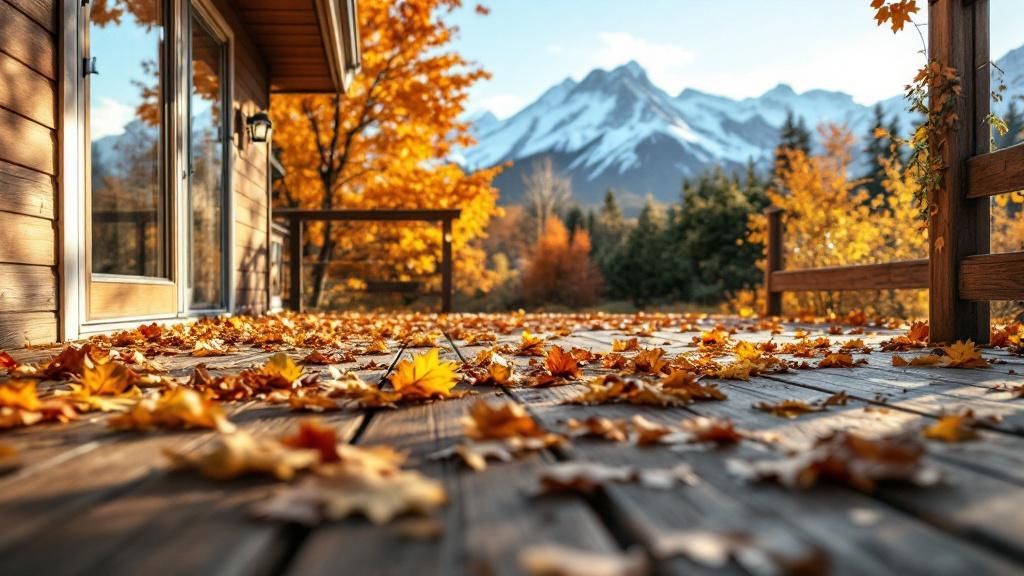
Preparing Your Deck for Anchorage’s Extreme Seasons
Key Takeaways
-
Anchorage’s climate demands seasonal deck preparation to extend lifespan and protect safety.
-
Regular cleaning, sealing, and inspections are essential before and after winter.
-
Material choice—especially composite decking or winter-resistant wood—affects performance.
-
Adjusting maintenance practices prevents warping, rot, and frost-related damage.
-
Proper foundation depth and drainage prevent frost heave and structural shifting.
Whether you’re looking to preserve an existing deck or build a new one in Anchorage, Alaska, understanding how to prep your deck for seasonal changes is critical. With freeze-thaw cycles, snow buildup, and intense UV exposure, your deck needs more than just casual upkeep—it needs an informed, seasonal approach.
This guide outlines essential strategies to protect your investment and keep your outdoor space safe and beautiful year-round.
Anchorage Winters: Why Seasonal Prep Matters
In Anchorage, winter hits hard. Wood and composite decks alike are vulnerable to:
-
Ice and snow buildup that accelerates wear
-
Moisture penetration that causes warping and cracking
-
Freeze-thaw cycles that lead to structural shifting
Must-Do Winter Prep Tasks:
-
Sweep off debris and organic buildup before snow hits
-
Apply water-repellent sealant (especially on wood decks)
-
Inspect railings and boards for weakness or cracks
-
Ensure drainage away from the house and deck base
These steps minimize ice hazards and long-term damage.
Smart Spring & Fall Maintenance Routines
Prepping your deck isn’t a one-time task. Spring and fall are ideal times to clean, inspect, and repair.
Spring Focus:
-
Clear leftover snow, dirt, and mold
-
Pressure wash gently (avoid damaging wood fibers)
-
Recheck drainage and deck slope
Fall Focus:
-
Remove grease, leaves, and furniture stains
-
Trim overhanging branches
-
Cover or store outdoor furniture
Consistent seasonal care prevents hidden damage and saves money over time.

Deck Materials That Perform in Alaska
Not all decking holds up well in harsh climates. In Anchorage, smart material choices can reduce maintenance and extend the life of your deck.
Reliable Decking Options:
-
Composite Decking: Low-maintenance, resists cracking and rot
-
Premium Softwoods: Cedar and redwood perform well when sealed properly
-
Hardwoods like Ipe or Island Decking: Durable but may require oiling
Avoid:
-
Materials with poor traction in icy conditions
Composite options are especially popular for homeowners looking to reduce upkeep and still enjoy attractive finishes year-round.
Anchorage Construction Standards & Frost Heave Protection
Building or upgrading a deck in Alaska requires specific construction knowledge:
-
Footing Depth: Posts should be installed 4–5 feet deep to stay below the frost line
-
Proper drainage: Prevents ice buildup around foundation points
-
Stable guardrails: Essential for safety on elevated decks in snowy seasons
Working with professionals familiar with Anchorage code and terrain ensures your deck won’t shift or crack over time.
Preventative Deck Care Tips
Minor changes in how you use your deck can make a big difference:
-
Use synthetic outdoor rugs to avoid mold and mildew
-
Rearrange furniture to prevent sun bleaching or pressure spots
-
Avoid using rock salt—opt for calcium magnesium acetate instead
-
Check fasteners and hardware for rust each spring
These simple habits preserve both beauty and structural safety.
Deck Trends That Work in Cold Climates
Alaskans are increasingly turning to deck designs that balance aesthetics with practicality:
-
Wider stairs for safer winter access
-
Built-in benches and planters to reduce clutter
-
Raised decks with storage underneath for seasonal items
-
Composite surfaces with wood accents for design contrast
Titan has helped numerous Anchorage homeowners bring modern, climate-aware deck designs to life—combining function and form in every project.

Common Deck Problems and How to Fix Them
Anchorage weather presents a unique set of challenges for deck maintenance. Look out for:
Common Issues:
-
Warping or cracking from freeze-thaw
-
Rusted fasteners or lifted boards
-
Rot and mildew from trapped moisture
Solutions:
-
Replace affected boards promptly
-
Re-seal or stain exposed wood surfaces
-
Clean with mild detergent or deck cleaner
-
Tighten or replace corroded screws and brackets
Don’t wait until small problems turn into structural concerns. Early intervention saves time and money.
Why Titan Is a Trusted Decking Partner in Anchorage
With deep experience in cold-climate construction and landscaping, Titan offers residential deck services that prioritize longevity, code compliance, and aesthetic value. From new builds using composite or hardwood materials to seasonal repairs and sealing, their team understands how to create decks that stand up to Anchorage’s extremes.
Titan’s team helps homeowners navigate material choices, foundation specs, and year-round care planning—ensuring you don’t just build a deck, you build something that lasts.
FAQs
How often should I reseal my wood deck in Anchorage?
Every 1–2 years is ideal, depending on the sealant used and level of weather exposure.
What’s the best time to build or replace a deck in Anchorage?
Late spring to early fall offers the best conditions for construction and proper curing.
Can I use rock salt to de-ice my deck?
Avoid rock salt—it can damage finishes and corrode fasteners. Use a safer de-icer like calcium magnesium acetate.
Should I cover my deck in winter?
Not necessarily, but storing furniture and ensuring proper drainage around the deck is crucial to prevent moisture buildup.
Is composite decking slippery in icy conditions?
Most quality composites have textured surfaces to improve traction, but care should still be taken during snow and ice.